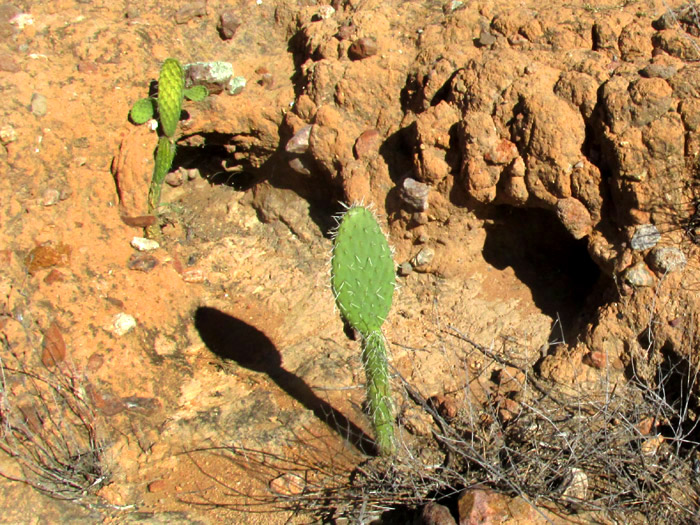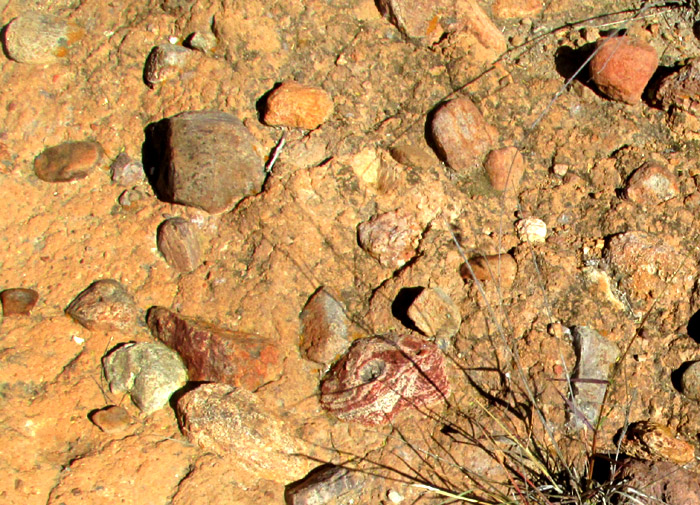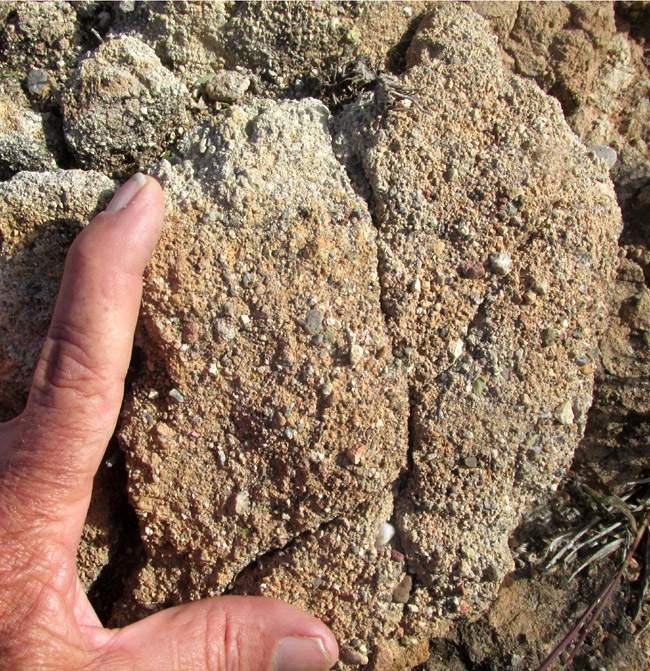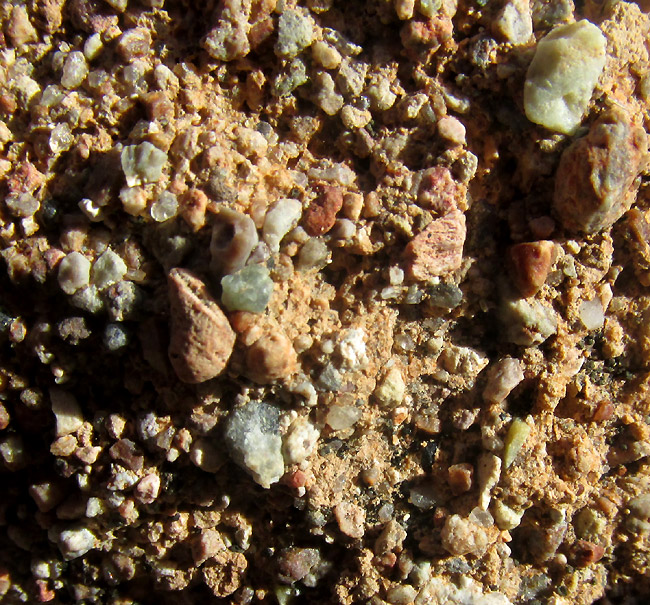Excerpts from Jim Conrad's
Naturalist Newsletter
Entry dated January 11, 2024, issued from near Tequisquiapan; elevation about 1,900m, (6200 ft), ~N20.57°, ~W99.89°; Querétaro state, MÉXICO
A BED OF BRECCIATED TUFF

On the 2007 Mexican Geological Service's Geological Mining Map, the Carta Geológico-Minera, entitled "Tequisquiapan F14-C67 Querétaro e Hidalgo", the late Miocene (~5 million years old) "bedrock" of our area is identified as the TmplTDa type, in Spanish meaning toba dacítica, or dacitic tuff. Dacite is a fine-grained volcanic rock formed by the rapid solidification of lava that is high in silica; it's a transition rock between andesite and the rhyolite of which neighboring extinct volcanoes are formed. Tuff is a relatively soft, porous rock usually formed by the compaction and cementation of volcanic ash or dust. Presumably, the term dacitic tuff means tuff produced by a volcano whose lava hardens into dacite.
In this immediate area, the relatively soft "bedrock" mostly consists of compacted and weakly cemented volcanic ash from volcanoes erupting in the area about five million ears ago. In Mexico, such tuff is called tepetate; in other countries it has different names. Here, deep tuff deposits are interbedded with various deposits other than pure tuff, such as white layers of ancient, chemically precipitated salts resulting from through evaporation of water from ash layers. Above we see another kind of much harder layer sandwiched between layers of tuff, outcropping in a deep erosional gully. In the above picture, note that behind the lower cactus the bedrock is whitish, while above the white layer it's reddish. The whitish horizon at the bottom is an ancient bed of tuff, while the material above it is reddish brecciated tuff developed from material later deposited atop the tuff. Below is a close-up of the brecciated tuff.

The rocks appearing to lie loose are actually embedded within the hard-compacted, weakly cemented tuff. With effort, the rocks can be pulled from the tuff matrix, because the tuff itself is soft enough to scrape away with a fingernail. Some rocks are less encrusted with brown, dried-mud-looking matter because they have been exposed longer to rain, and the crust has eroded away. In the picture below, a pink-and-white-banded rock of rhyolite from nearby volcanic hills composed of rhyolite is prominent.

The term "brecciated tuff" is based on the word breccia. Breccia is a rock composed of large angular broken fragments of minerals or other rocks cemented together by a fine-grained matrix; it's rocks inside a rock. Our brecciated tuff once was loose volcanic ash mixed with the rocks seen and suggested in the above photo. Over time, this mixture was so deeply buried beneath more volcanic layers -- most of which weren't mixed with loose rocks -- until pressure from above compressed the mixture, causing it to lithify into our pinkish brecciated tuff rock. Various kinds of brecciated tuff exist. As opposed to breccia developed from magma cooling inside a volcano, ours is sedimentary, formed outside volcanoes.
In the field, it can be hard to figure out how outcroppings of brecciated tuff were produced. Deposits resulting from liquified mixtures of ash and rock after flooding can be referred to as turbidites. In profound contrast, hot ash being ejected from a volcano can mix with loose rocks on the ground during pyroclastic flows. Pyroclastic flows are fast-moving currents of hot gas and ejected volcanic matter known as tephra, flowing along the ground away from an erupting volcano. Pyroclastic flows can move as fast as 700km/h (430mph) and reach temperatures of about 1,000°C (1,800 °F). Such highly destructive debris flows often are referred to as lahars.
Was our pink brecciated tuff once a peaceful mudflow resulting from local flooding of a thick bed of loose ashes, or from a rampaging lahar killing everything in its path?
I can't say for sure, but I do know that this local area around Tequisquiapan, Querétaro in upland central Mexico is surrounded by ancient volcanoes along the northern boundary of the Trans-Mexican Volcanic Belt. Also, that the famous Peña de Bernal Monolith, which surely produced a whopper lahar, rises only about 27km (17miles) NNW of us. In fact, currently at the ThinkHazard.Org website, sponsored by the Global Facility for Disaster Reduction and Recovery and the World Bank, our immediate area is rated at high risk for volcanic eruption, and lahars are mentioned there as one of the risks.
Therefore, there's certainly no reason why our pinkish brecciated tuff outcrop was not produced by a lahar, though it may also have been deposited as a simple ancient mudslide. In fact, my best guess is that our harder-than-tuff, pinkish deposit is a turbidite (liquified mixture of ash and rock from flooding), not resulting from a lahar or other sizzling pyroclastic flow.
That's because the mud-like crust covering the rocks mixed in the flow can be removed relatively easily. Under high heat, probably that crust, composed mostly of ash particles, would have been "welded" more securely to the larger rocks particles. The particles would stick because water and mineral compounds chemically cement the particles, not by melting and fusing them with heat. Here's a closer look at an encrusted rock:

Here's a close-up of the grains covering the above rocks:

Again, individual grains appearing to lie loose on the surface actually adhere to the surface, though they can be scraped off with a fingernail. Individual grains often are quite clean, where the crust has come undone in complete flakes. If the crust, composed of much smaller ash particles, had been heat-welded to the small grain's surfaces, the grains' surfaces wouldn't be as clean of ash remnants.
At least, that's my theory, though I'm certainly no expert on this little corner of geology. If I'm right, then the above pictures show features of what can be termed a "mixed pyroclastic-epiclastic rock."